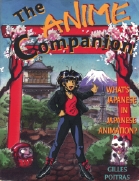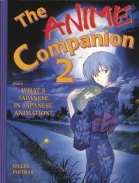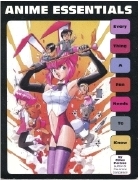 |
Anime Companion Supplement - Z
Za -Ze - Zo
This series of pages is a supplement to two of my books The Anime
Companion and The Anime Companion 2.
For easy browsing go to the: Topical / Subject Index
See the regular entry pages for cross references between variant terms, differing spellings, English to Japanese terms and names:
# - A - B - C - D - E - F - G - H - I - J - K - L - M - N - O - P - Q - R - S - T - U - V - W - Y - Z - Side Bars Special Supplement: Rurouni Kenshin OVAs
- Each Supplement page consists of:
-
1. A list of entries in the books with page numbers.
2. New entries for items not found in the books.
3. Japanese characters for entries
4. Secondary sources used to find information for each entry.
5. Additional information for some entries.
6. Links to select Internet resources related to the entries.
You can also search my entire site:
|
 |
For more information about this supplement see The Anime Companion Supplement main page. Additions are announced in the Anime Companion Supplement News page and in my Blog.
Hyphenated Japanese terms are listed as single words.
The inclusion of an anime or manga title in these entries is not a recommendation of that title, see my Recommended Anime and Manga page for a list of my recommendations
- zabuton (floor cushion) 座布団 (The Anime Companion [vol.1] p.150)
- Sources:
Japan: An Illustrated Encyclopedia p.1768
- zainichi beigun (United States Armed Forces in Japan) 在日米軍 (The Anime Companion 2 p.120)
- Sources:
Japan: An Illustrated Encyclopedia p.1659
Various Fuji TV News broadcasts on incidents involving U.S. military personnel.
- zainichi kankokujin to chōsenjin (Koreans in Japan) 在日韓国人と朝鮮人
-
Presently Koreans and persons of Korean parentage form the largest minority group in Japan. It is estimated that there were about 2,500 Koreans in Japan in 1910, the year the Japanese annexed Korea. Koreans then became citizens of the Japanese Empire. During WWII large numbers of Koreans were relocated to Japan to provide labor in factories and mines. At the end of the war about 2 million were there, many of whom would return home. In 1952 Japan stripped the remainder of their citizenship, including children born in Japan. By 1990 there were roughly 688,000 Koreans in Japan, 90% were born there of Korean parents. Those of mixed Korean and Japanese ancestry are not counted in this figure as they are considered Japanese by law. Koreans in the post war period have had to suffer economic hardship due to discrimination. This is improving as the government has passed anti-discrimination laws and court battles have extended the rights of foreigners living in Japan. There are many Korean institutions in Japan for example: residence rights organizations, religious bodies and many Korean students go to Korean schools, the largest being in Tokyo. In 1981 and 1991 the government declared that Koreans who were living in Japan prior to W.W.II have permanent residence as do their descendants.
Manga:
In The Times of Botchan (v.2 p.106) we read that one of the characters died after the Great Kanto Earthquake (see: Kantō Daisinsai; The Anime Companion 2 p.41) trying to stop one of the massacres of Koreans that took place then.
In Barefoot Gen (v.1 p.60, 70) the Korean neighbor Mr Pak is kind to Gen's family when they are in need.
Che in Eden (v.4 p.60) talks about how when he was a kid he was called "kimchi breath" and had rocks thrown at him.
Sources:
De Mente, Boye Lafayette. Japan Encyclopedia p. 289
Japan: An Illustrated Encyclopedia p.830
Reader, Ian. Religion in Contemporary Japan p.122
- zaisu (legless chair) 座椅子 OLD FORM 坐椅子 (The Anime Companion 2 p.120)
- Sources:
Japanese Inn and Travel p.43
- zakuro (pomegranate) 石榴 or 柘榴 (The Anime Companion 2 p.121)
- Sources:
Joya, Mock. Mock Joya's Things Japanese p.400
Japan in a Nutshell vol. 1 p. 34-
- zaru soba ざるそば or 笊蕎麦
-
A dish of cold soba (The Anime Companion 2 p.90) with nori (The Anime Companion [vol.1] p.97) strips on top. This is traditionally served on a bamboo tray placed in a lacquer box .
Anime:
We see zaru ordered, and consumed, several times in episode 36 of City Hunter 2.
Sources:
Nagasawa Kimiko & Camy Condon. Eating Cheap in Japan p.36, 37, 66 (item)
Eating in Japan p.91
Hosking, Richard. Dictionary of Japanese Food p.177
- Zashiki Warashi 座敷童 (The Anime Companion [vol.1] p.150)
- Sources:
Japan: An Illustrated Encyclopedia p.1771
- zazen (Zen meditation) 坐禅 or 座禅 OLD FORM 坐禪 (The Anime Companion 2 p.121)
- Sources:
Japan: An Illustrated Encyclopedia p.1773
ZEKE FIGHTER see: Zerosen (aircraft) (The Anime Companion 2 p.122)
- zeichiku 筮竹 (The Anime Companion 2 p.121)
- Sources:
A Look Into Japan p.106
Japan: An Illustrated Encyclopedia p. 288
Oracles and Divination p. 47
ZELKOVA see: keyaki (The Anime Companion 2 p.45)
- Zen (Buddhism) 禅 FORMAL 禪 (The Anime Companion 2 p.122)
- Sources:
Frederic, Louis. Japan Encyclopedia p.86
Japan: An Illustrated Encyclopedia p.1772
- zen (small individual table for food) ぜん or 膳 (The Anime Companion 2 p.122)
- Sources:
Hosking, Richard. Dictionary of Japanese Food p.177
- Zenki 前鬼 (The Anime Companion [vol.1] p.150)
- Sources:
Japan: An Illustrated Encyclopedia p.1151
Blacker, Carmen. The Catalpa Bow p.210
ZEN MEDITATION see: zazen (The Anime Companion 2 p.121)
ZEN STICK see: keisaku (The Anime Companion 2 p.44)
- Zenigata Heiji 銭形平次
-
A fictional character from the Zenigata Heiji torimono hikae stories set in the Edo Period (The Anime Companion [vol.1] p.25) and written by Nomura Kodō between 1931 and 1958, the original tale being so popular that more than 400 other were written. These tales stared a detective, inspired by Sherlock Holmes, who could bring down a criminal by tossing coins at him. There were also movies and TV shows based on the tales. In the stories Zenigata lived near Kanda Myojin (Kanda Jinja) and there are stone monuments for him and his assistant Hachigoro to the right of the main building.
Anime and Manga:
Zenigata in the Lupin III stories is a descendant of Zenigata Heiji
Anime:
In the Urusei Yatsura TV series (ep. 54 story 77) Ataru thinks he is Zenigata Heiji.
In episode 6 of New Cutey Honey the grandfather mentions Zenigata Heiji after Honey, dressed as Nezumi Kozō (The Anime Companion 2 p.62), tosses koban, gold coins, at the Shinsengumi (The Anime Companion 2 p.86) in Samurai Park.
Sources:
Enbutsu Sumiko. Old Tōkyō: Walks in the City of the Shōgun p. 75
Japan: An Illustrated Encyclopedia p.1112
- zenza 前座
-
A rakugo apprentice advanced enough to begin performing. Traditionally the was done under a shishō, a master, while living in their house, these days they visit regularly to help out. There was no formal instruction at the beginning, instead they would do the chores at the home of their shishō and at the yose. During this time the apprentice is called a minarai, "one who learns by watching." After 6 months or so they start learning stories and perform them for their shishō, if he thinks they are good enough he will give them a stage name and they become zenza. Traditionally these names would have a kanji (The Anime Companion 2 p.40) from their master's name.
Zenza can be translated as "pre-session" as they perform at the yose telling short stories before those who are on the actual schedule. They continue to do chores during their zenza period, which can last for 3 to 5 years. An addition to their chores usually includes beating the drum to signal the beginning of a program of new act. The yose chores, which cover almost everything backstage, are particularly important as they include a great many elements of stage managing. Learning at this stage was mainly done by observation of other performers including their senior apprentices. During their time as a zenza they would study directly under their master often for several days a week. Now days the use of video and audio recordings of tales is also common. After at least 3 years the zenza may be promoted to futatsume "2nd," the intermediate rank above zenza.
Anime:
Zenza moving up to futatsume is mentioned by Shin-san in Showa Genroku Rakugo ep. 3
Manga:
Descending Stories Showa Genroku Rakugo Shinju v. 1 Yotaro's Odyssey ch. II p. [48
Sources:
Rakugo Performing Comedy and Cultural Heritage in Contemporary Tokyo p.17, 92, 109-137, 122
Rakugo The Popular Narrative Art of Japan p.2, 22-24, 257
- Zerosen (Zero Fighter) ゼロ戦 or 零戦 (REISEN) OLD FORM 零戰 (The Anime Companion 2 p.122)
- Sources:
Japan: An Illustrated Encyclopedia p.1779
Mikesh, Robert C. Japanese Aircraft p.147, 171
ZERO-TYPE CARRIER-BASED FIGHTER see: Zerosen (aircraft) (The Anime Companion 2 p.122)
- zōki ishioku (organ transplant) 臓器移植 (The Anime Companion [vol.1] p.150)
- Sources:
Japan: An Illustrated Encyclopedia p.119
Supplementary information:
On March 1, 1999 the NHK (Nippon Hō sō Kyō kai, The Anime Companion [vol.1] p.96) news show Dayline Japan reported the first organ transplants done under the 1997 law redefining brain death. The organs were the heart, liver and kidneys of a woman in her 40s.
- zōmen (white square mask) 蔵面 or 造面 or 雑面 OLD FORM 藏面 or 雜面 (The Anime Companion 2 p.123)
- Sources:
Ortolani, Benito The Japanese Theatre p.48, illustration 19
- zōni 雑煮 (The Anime Companion [vol.1] p.150)
- Sources:
Japan: An Illustrated Encyclopedia p.1780
- zōri (thonged sandals) 草履 (The Anime Companion [vol.1] p.151)
- Sources:
Outlook on Japan p.38
Japan: An Illustrated Encyclopedia p.395, 1781
ZUNBERABŌ see: Nopperabō (faceless yōkai)
ZURŌSU DOROBŌ see: pantī dorobō (panty thief)
ZŌZUSAN KONPIRA DAI-GONGEN see: Kompira
Go To: Topical Index
# - A - B - C - D - E - F - G - H - I - J - K - L - M - N - O - P - Q - R - S - T - U - V - W - Y - Z - Side Bars
Special Supplement: Rurouni Kenshin OVAs
You can also search my entire site:



